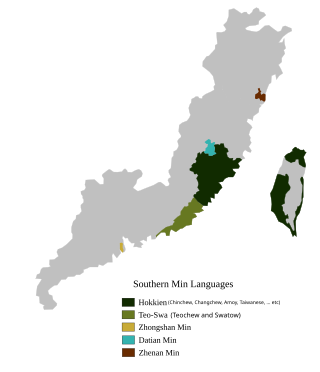
Mandarin is a group of Chinese language dialects that are natively spoken across most of northern and southwestern China. The group includes the Beijing dialect, the basis of the phonology of Standard Chinese, the official language of China. Because Mandarin originated in North China and most Mandarin dialects are found in the north, the group is sometimes referred to as Northern Chinese. Many varieties of Mandarin, such as those of the Southwest and the Lower Yangtze, are not mutually intelligible with the standard language. Nevertheless, Mandarin as a group is often placed first in lists of languages by number of native speakers.

Standard Chinese is a modern standard form of Mandarin Chinese that was first codified during the republican era (1912‒1949). It is designated as the official language of mainland China and a major language in the United Nations, Singapore, and Taiwan. It is largely based on the Beijing dialect. Standard Chinese is a pluricentric language with local standards in mainland China, Taiwan and Singapore that mainly differ in their lexicon. Hong Kong written Chinese, used for formal written communication in Hong Kong and Macau, is a form of Standard Chinese that is read aloud with the Cantonese reading of characters.

Hakka forms a language group of varieties of Chinese, spoken natively by the Hakka people in parts of Southern China and some diaspora areas of Taiwan, Southeast Asia and in overseas Chinese communities around the world.

Min is a broad group of Sinitic languages with about 70 million native speakers. These languages are spoken in Fujian province as well as by the descendants of Min-speaking colonists on the Leizhou Peninsula and Hainan and by the assimilated natives of Chaoshan, parts of Zhongshan, three counties in southern Wenzhou, the Zhoushan archipelago, Taiwan and scattered in pockets or sporadically across Hong Kong, Macau, and several countries in Southeast Asia, particularly Singapore, Malaysia, the Philippines, Indonesia, Thailand, Myanmar, Cambodia, Vietnam, Brunei. The name is derived from the Min River in Fujian, which is also the abbreviated name of Fujian Province. Min varieties are not mutually intelligible with one another nor with any other variety of Chinese.

Southern Min, Minnan or Banlam, is a group of linguistically similar and historically related Chinese languages that form a branch of Min Chinese spoken in Fujian, most of Taiwan, Eastern Guangdong, Hainan, and Southern Zhejiang. Southern Min dialects are also spoken by descendants of emigrants from these areas in diaspora, most notably in Southeast Asia, such as Singapore, Malaysia, the Philippines, Indonesia, Brunei, Southern Thailand, Myanmar, Cambodia, Southern and Central Vietnam, San Francisco, Los Angeles and New York City. Minnan is the most widely-spoken branch of Min, with approximately 48 million speakers as of 2017–2018.

Cantonese is a language within the Chinese (Sinitic) branch of the Sino-Tibetan languages originating from the city of Guangzhou and its surrounding Pearl River Delta. It is the traditional prestige variety of the Yue Chinese group, which has over 82.4 million native speakers. While the term Cantonese specifically refers to the prestige variety, it is often used to refer to the entire Yue subgroup of Chinese, including related but partially mutually intelligible varieties like Taishanese.

The Hoklo people are a Han Chinese subgroup who speak Hokkien, a Southern Min language, or trace their ancestry to Southeastern Fujian, China and known by various endonyms or other related terms such as Banlam (Minnan) people or more commonly known in southeast asian countries as Hokkien people. The Hokkien people are found in significant numbers in Mainland China (Fujian), Taiwan, Singapore, Malaysia, Philippines, Indonesia, Brunei, Myanmar, the United States, Hong Kong, and Macau. The Hokkien people have a distinct culture and architecture, including Hokkien shrines and temples with tilted sharp eaves, high and slanted top roofs, and finely detailed decorative inlays of wood and porcelain. The Hokkien language, which includes the Taiwanese Hokkien dialect, is the mainstream Southern Min (Minnan), which is partially mutually intelligible to the Teochew language, Hainanese, Luichew, Hailokhong.
The Han Chinese people can be defined into subgroups based on linguistic, cultural, ethnic, genetic, and regional features. The terminology used in Mandarin to describe the groups is: "minxi", used in mainland China or "zuqun", used in Taiwan. No Han subgroup is recognized as one of People's Republic of China's 56 official ethnic groups, in Taiwan only three subgroups, Hoklo, Hakka and Waishengren are recognized.

The Cantonese people or Yue people, are a Han Chinese subgroup originating from or residing in the provinces of Guangdong and Guangxi, in Southern Mainland China. In a strict sense, "Cantonese" refers only to people with roots from Guangzhou and its satellite cities and towns, rather than generally referring to the people of the Liangguang region.
Standard Chinese is a standard form of Mandarin Chinese with de facto official status in China, Taiwan, and Singapore.

Taiwanese Mandarin, frequently referred to as Guoyu or colloquially as Huayu, is the variety of Mandarin Chinese spoken in Taiwan. A large majority of the Taiwanese population is fluent in Mandarin, though many also speak a variety of Min Chinese known as Taiwanese Hokkien, commonly called Minnanyu, Southern Min, or Hokkien. This language has had a significant influence on Mandarin as spoken on the island.
Star Chinese Movies was a Chinese language pay television channel owned by Disney Networks Group Pacific Ltd. It features Chinese films.

The languages of Taiwan consist of several varieties of languages under the families of Austronesian languages and Sino-Tibetan languages. The Formosan languages, a geographically designated branch of Austronesian languages, have been spoken by the Taiwanese indigenous peoples for thousands of years. Owing to the wide internal variety of the Formosan languages, research on historical linguistics recognizes Taiwan as the Urheimat (homeland) of the whole Austronesian languages family. In the last 400 years, several waves of Han emigrations brought several different Sinitic languages into Taiwan. These languages include Taiwanese Hokkien, Hakka, and Mandarin, which have become the major languages spoken in present-day Taiwan.
Malaysian Mandarin (simplified Chinese: 马来西亚华语; traditional Chinese: 馬來西亞華語; pinyin: Mǎláixīyà Huáyǔ; Wade–Giles: Ma3-lai2-hsi1-ya4 Hua2-yü3) is a variety of Mandarin Chinese spoken in Malaysia by ethnic Chinese in Malaysia. Today, Malaysian Mandarin is the lingua franca of the Malaysian Chinese community.
Singaporean Mandarin is a variety of Mandarin Chinese spoken natively in Singapore. It is one of the four official languages of Singapore along with English, Malay and Tamil.

Hokkien is a variety of the Southern Min Chinese languages, native to and originating from the Minnan region, in the southeastern part of Fujian in southeastern mainland China. It is also referred to as Quanzhang, from the first characters of the urban centers of Quanzhou and Zhangzhou.
Standard Singaporean Mandarin is the standard form of Singaporean Mandarin. It is used in all official Chinese media, including all television programs on Channel 8 and Channel U, various radio stations, as well as in Chinese lessons in all Singapore government schools. The written form of Chinese used in Singapore is also based on this standard. Standard Singaporean Mandarin is also the register of Mandarin used by the Chinese elites of Singapore and is easily distinguishable from the Colloquial Singaporean Mandarin spoken by the general populace.
The usage of Chinese by the Chinese diaspora and their descendants has been determined by a large number of factors, including their ancestry, their migrant ancestors' "regime of origin", assimilation through generational changes, and official policies of their country of residence. The general trend is that more established Chinese populations in the Western world and in many regions of Asia have Cantonese as either the dominant variety or as a common community vernacular, while Mandarin is much more prevalent among new arrivals, making it increasingly common in many Chinatowns, though still not dominant.
Malaysian Cantonese is a local variety of Cantonese spoken in Malaysia. It is the lingua franca among Chinese throughout much of the central portion of Peninsular Malaysia, being spoken in the capital Kuala Lumpur, Perak, Pahang, Selangor and Negeri Sembilan, it is also widely understood to varying degrees by many Chinese throughout the country, regardless of their ancestral language.










